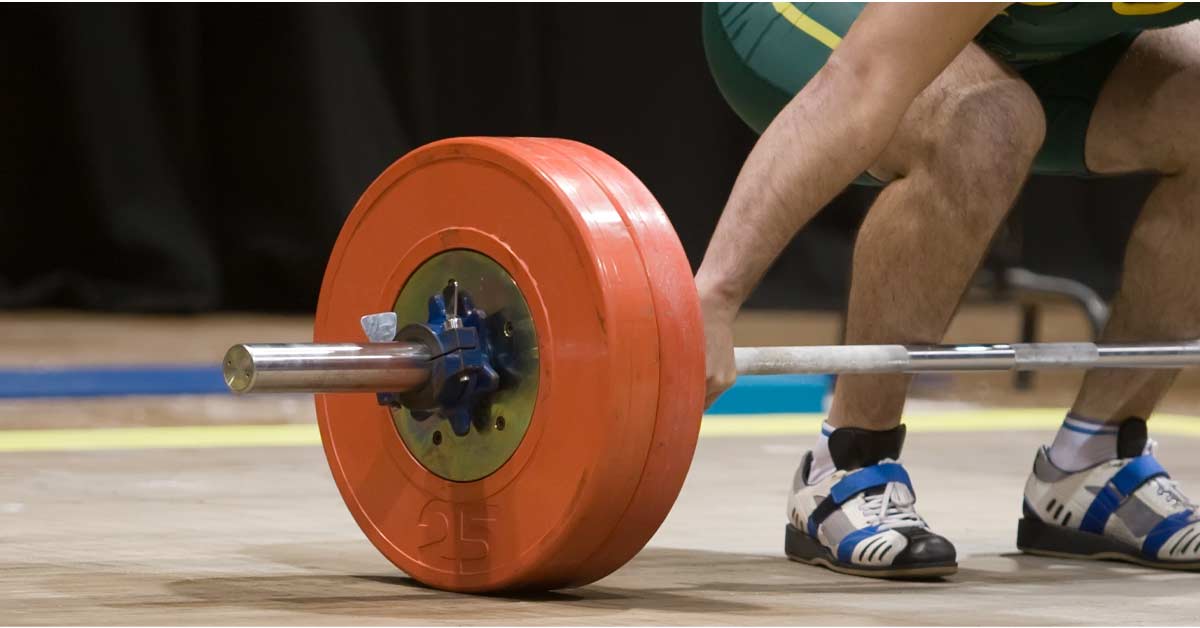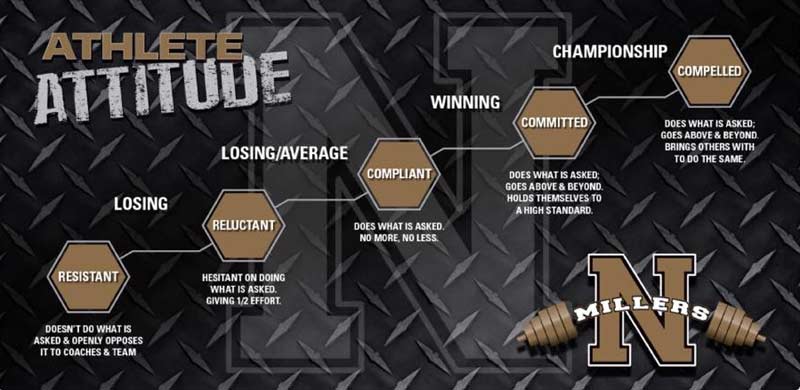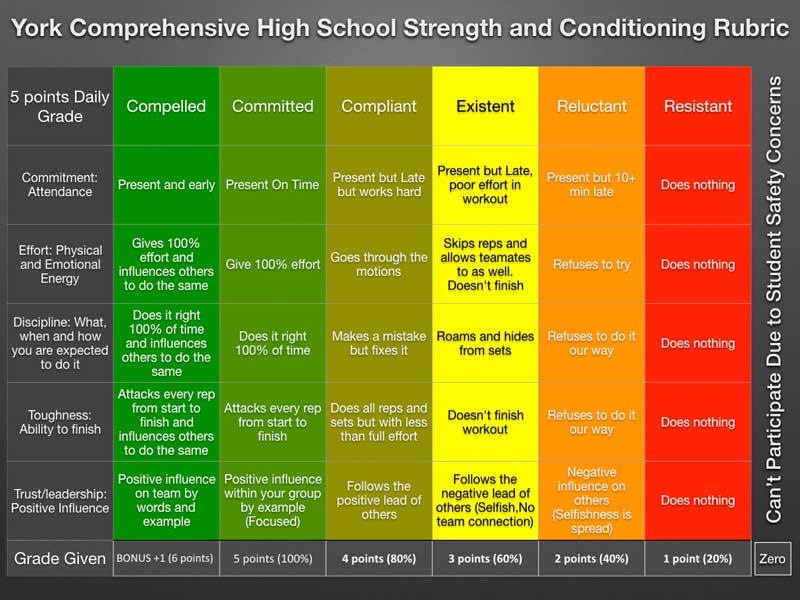[mashshare]
Culture is a word that’s highly overused in the world of strength and conditioning. The word itself holds little meaning and is very vague. We as coaches have to look at our little section of the sports performance world and give it values and meaning that will translate to our athletes. That’s the easy part. Once we have defined culture, we have to go about living it. A truly great culture can’t be faked. The values you lay out must resonate daily across your program.
The Origin of the Rubric
When I left my last job to come to York Comprehensive High School (YCHS), I had a unique situation regarding weight room culture, specifically with football. At my previous job, our football program was not a highly successful one from a win-loss standpoint. However, our culture in the weight room was outstanding.
At YCHS it was the reverse. Although wins were more plentiful, our weight room culture was far from what I would define as high performing. I immediately started down a path to find ways to help educate our athletes about what a high-performance culture looks and feels like. Regardless of wins and losses, at some point, a poor culture will want its “pound of flesh.” Our goal was to minimize this while taking our culture to a much higher level.
Step one was to come up with a list of characteristics we wanted the athletes to strive for. Things that we could recognize our athletes doing or failing to do daily. We made a list of ten characteristics of the high-performance culture we wanted at YCHS. Number one was “Always have correct footwear in the weight room.” As you can see from the fact that something so basic was such a big issue, we had lots of work to do!
We talked to the athletes about the list. We made signs and wrote the list on our whiteboard. We referenced it daily. We stopped and recognized high-performance actions. But things did not change. I needed something more.
I spoke with our AD, who advised me to find a way to grade our athletes that would encourage them to meet our expectations. Attack the issue as if it were any other classroom with problems. We needed to evaluate how athletes would earn grades in athletic classes. If you tell an athlete “hey do better, or your grade will drop” they have no idea what that means. How much? What exactly do I need to do better? We were preaching attention to detail, but we were not living it.
At that moment, I knew I needed to think less like a strength coach and more like a classroom teacher. I needed a rubric for a high-performance culture.

Luckily for me, I had the beginning of this rubric already on hand. The previous June, I attended the NHSSCA NatCon in Noblesville, Indiana. Noblesville is the home of one of the great high school strength coaches in America, Brian Clarke. Brian had an amazing sign in his facility that listed five characteristics of athlete behavior: Resistant, Reluctant, Compliant, Committed, and Compelled. Connecting each was a “category” of expected outcome for each. For example, between Resistant and Reluctant was Losing. Each characteristic had a definition below it (see graphic above). I added a sixth trait I called Existent—just showing up and breathing and trying to get through the day.
Implementing and Applying the Rubric
My next step was to figure out what traits would stand as the pillars upon which to build our new culture. What were the graded assignments going to be each day? We went with Commitment, Effort, Discipline, Toughness, and Trust/Leadership. Each of these would be worth one point. Now we had our assignments and our characteristics categories. I also decided to keep five graded categories and all six levels of achievement. We reserved Compelled for extraordinary efforts worth one extra credit point. This gave athletes the potential to score six out of five and allowed an athlete to make up for an off day by having a great one.
The final step to building the rubric was to give them a specific action they needed to accomplish within each level. We could not afford to be vague or leave too much open to interpretation. I sat down and researched the exact wording for each step in the rubric. We kept the descriptions short and to the point, which could be easily referenced and understood by athletes and coaches alike.
Finally, we put it together and jumped in with both feet immediately after our final game last football season. We were going through a coaching change, which made it a perfect time for a major change in the weight room as well. I was able to freely make the changes I felt would make a difference in our room. Luckily, our new head coach came in with an extremely similar mindset, which has made a major impact so far.
We made sure the athletes understood each level that would dictate their daily grades. That was a big change for them. Previously, my football classes were viewed as “football.” I needed to make sure I set up my classroom with my expectations. And just as in an academic classroom, reinforcement of expectations became a focus.
I had a four-pronged plan to reinforce the rubric. First, we went to the athletes who were leaders and explained how they could help us build and protect our culture. Second, we pulled aside athletes individually who were not performing up to rubric standards. Steps three and four both emphatically pointed out individuals and whole groups who showed efforts that could “make them a six.”
We saw immediate improvements within the program. Athletes are competitive by nature, and the rubric turned into a competition. Before I knew it, other athletes outside of football were looking at it and wanted to be a part of it. Leaders began to emerge where none had existed.
Because athletes are competitive by nature, the rubric turned into a competition and we saw immediate improvements, says @YorkStrength17. Share on XOne of my most eye-opening moments happened during the after school program when a rising senior volleyball player approached me. She said, “Coach I love this high-performance culture stuff. I love this rubric. Can we meet and talk about ways I can help get this in volleyball? We have a chance to be really good. I want to be great my senior year.” We ended up sitting down for a 45-minutes discussion. That right there is our why as strength coaches. Moments like that make it all worth it!
Since we began using the rubric in November, we’ve had our ups and downs. It’s rewarding to have our athletes coming into the room talking about “being a six.” It’s also tough when I have to lower a grade. I can say we have athletes flirt with a grade of C and a few with low B grades, though every one of these athletes improved following a grade report lower than an A.
How to Score the Rubric
The actual process of scoring the rubric was probably the hardest part of the rubric development. To score so many athletes, we had to keep it simple. I decided to go with a five-point scale (plus the extra credit point for Compelled). I use that as 20% of the weekly grade per day. In hindsight, I would have used a 20-point scale per day simply to make the calculations easier when entering grades. My first thought about the daily scoring was that a four out of five would move an athlete to the next level. However, I had a change of heart about that. We’re going for an excellent culture (A grade), not an above average culture (B grade). If four out of five were the standard, we would be lowering expectations.
Currently, athletes are graded up to the point where their actions no longer meet the standard expected. If an athlete wants to earn an A, or Committed, they must achieve all five goals listed in that column (see graphic below). To earn a six, they must be not only Committed but also Compelled to influence their teammates to a higher standard.

The day to day scoring can be time-consuming. At first, I tried to come up with a way to use Teambuildr software. As I played with it, though, I decided it was too much data entry. Our school has an online grade book, which gives 24/7 access to students and parents, and we chose to use that to push out the grades to our athletes. Again, we wanted to keep the process consistent with other academic procedures.
I keep a class roster on a clipboard for each group and make notes for each athlete. When I see something that is a six behavior, I star it. Everyone has a version of shorthand they use, and I’ve come up with my own for this effort as well. As with any classroom, you will not observe 100% of the athletes 100% of the time. For this situation, I stole a line directly from the teacher evaluation process: “You will be graded on observable behavior.”
I grade our athletes on what I see each day. I also do my best to talk to my leaders to see if I’ve missed anything. Students are resentful of other students who get the same grades for doing less, and this situation is no different. Our guys will call out people who are slacking. When I go to them and ask, I find out who’s been doing well and who has skipped reps.
I don’t let that information alone affect a grade, obviously; I’ll go to that student and observe and have a conversation. It can be very powerful to call an athlete over and have them point to the spot on the rubric they feel they fall. I’ve found that these moments reveal honesty and cause reflection. Once in a while, if the class has a noticeably great day, I’ll allow the group to grade itself. The athletes love this. Surprisingly, they are tough on themselves. I’ve not had a group give itself a six yet! It’s also educational for me to hear the reasons the athletes give for the grade.
Enhancing Athletic Performance Using the Rubric
As many programs do, we block our athletes from Block 0 (middle school and down), Block 1 (new lifter), Block 2 (Novice), Block 3 (Advanced), and Block 4 (Elite). The rubric plays a role in this system as well. Having a dedicated class of freshman athletes has been a great research lab for our scoring system. I’ve found almost no instances of Compelled or Committed in 9th-grade athletes to start. In fact, we have a few Resistant. Our best usually come to us as Compliant. Basically, they do what they’re told. The rest fall in the Existent to Reluctant range based on lack of understanding of expectations. Most are not hard to get to Compliant. None will be moved up to Novice unless they reach Compliant, regardless of relative strength goals or technique. Our goal for freshman is to be consistently Compliant and often score as Committed. This has become a very important step in our progression of steps our incoming athletes must master: move well, move fast, master technique, and master procedure.
Our Novice, Advanced, and Elite athletes have no such leeway. We expect them to score consistently in the Committed level. What we’ve seen from a performance-enhancing standpoint can’t be denied. My first off-season at YCHS was a battle to get many of our football players just to do the minimum. Skipping sessions, tardiness, not having the correct footwear, skipping sets and reps, cell phone use, not following the program, and open defiance were a daily battle. Obviously, all of these factors have a strong negative effect on performance. Not to mention it made my job extremely tough. It was also very frustrating for the athletes who did want to excel.
Skipping sessions, tardiness, cell phone use, not following the program, & open defiance have all but disappeared, @YorkStrength17. Share on XAs my second off-season started and we installed our high-performance culture rubric, these issues have all but disappeared. The anecdotal evidence is strong as well in favor of large effect. I can see our athletes growing into our desired culture. The “coach’s eye” is still one of the strongest indicators of success. It feels really good to hear “Coach I’m a six today—you watch” when guys are warming up. Even better when two of our rising seniors (both of whom I had issues with last year) began doing athlete-led cell phone checks to make sure no other athlete violated the cell phone restriction. I can give more evidence based on statistics as well. Our numbers are up percentage-wise across the board from a year ago. Many factors play into this; however, the quality of participation stemming from our rubric plays a large role.
Relationships with our athletes are clearly one of the most important aspects of our job. There are many ways we go about improving these daily. I’ve always prided myself on taking a moment to look at each of my athlete’s in the eye and ask them how they’re doing that day. While I still do this, I now have additional opportunities to grow these relationships daily. It’s important to keep the athletes aware of the direction they are heading on a daily basis.
This process is one of behavior modification. Human nature dictates that even your best, most committed athletes will slip occasionally. The rubric gives us actionable outcomes to monitor and provide feedback on those days. I’m also a big fan of daily readiness surveys and used them extensively over the last five years. While these surveys give us information, they can be fudged. The rubric system lets me observe our athlete’s actual behavior—most of the time without their knowledge. Now I have information that lets me know there may be an issue.
The rubric is an accountability tool that helps us increase athlete performance on a daily basis, says @YorkStrength17. Share on XAfter using the rubric for a while, athlete profiles develop. When a profile is off, most of the time we can talk to the athlete and get to the root of the issue. This allows us to adjust or assist the athlete, giving them what they need on the spot. It’s an accountability model in our toolbox that allows us to help our athletes’ performance increase on a daily basis. As they grow into the culture of high performance and strive for Compelled, every athlete that chooses to will improve. I can’t overstate the incremental gains our program has seen from athletes who follow our lead daily.
Use or Modify the Rubric for Your Situation
I hope you can take this information and use it in your program. The rubric will be a useful tool even for programs that already have a high-performance culture in place. It gives an athlete a measure of control over the outcome of a class or session. Feedback is important to them. “Why did I get an 85%?” can be a tough question to answer in a class that originates in a weight room. That’s become easy for us to answer because of the rubric.
While printing out the rubric and hanging it up obviously isn’t the path to greatness, it was the first step toward marked improvement in our strength program’s culture. As we move forward, living the standards it spells out will be the key to its continued usefulness as a tool in YCHS’s toolbox. Please feel free to use this rubric, change it to meet your needs, and anything else you see fit. And please don’t hesitate to contact me with questions.
Since you’re here…
…we have a small favor to ask. More people are reading SimpliFaster than ever, and each week we bring you compelling content from coaches, sport scientists, and physiotherapists who are devoted to building better athletes. Please take a moment to share the articles on social media, engage the authors with questions and comments below, and link to articles when appropriate if you have a blog or participate on forums of related topics. — SF
[mashshare]



